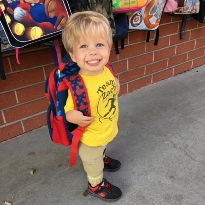Wayne's Story: "Feels" the Floor Through His Prosthetic Legs
As Wayne was healing after amputation, he could use traditional prostheses to walk short distances with forearm crutches, but osseointegration proved to be life-changing for him.
 The Amputee and Limb Loss Rehabilitation Program at TIRR Memorial Hermann prepares patients and their families to cope physically and psychologically with the traumatic or surgical loss of a limb or a congenital limb deficiency. The rehabilitation process includes a pre-prosthetic program and prosthetic training when appropriate.
The Amputee and Limb Loss Rehabilitation Program at TIRR Memorial Hermann prepares patients and their families to cope physically and psychologically with the traumatic or surgical loss of a limb or a congenital limb deficiency. The rehabilitation process includes a pre-prosthetic program and prosthetic training when appropriate.
The clinical treatment team of the Amputee and Limb Loss Rehabilitation Program at TIRR Memorial Hermann is internationally recognized, particularly for their work with patients with upper-limb and multiple amputations.

TIRR Memorial Hermann offers an interdisciplinary team approach to caring for children with limb loss throughout their lifetime. Whether limb loss is due to trauma, cancer or congenital reasons, we will create an individualized program that addresses all aspects of care for the patient and family.
As a Center of Excellence, the program has been awarded significant research grants, including one from the Veterans Administration entitled "Establishing Standards of Care: Upper Limb Prosthetic Services," and a grant from the National Aeronautics and Space Administration for "Applying Space Technology to Enhance Control of an Artificial Arm."
 TIRR Memorial Hermann is affiliated with the Amputee Coalition, a leading advocacy group for amputees and their families, to provide education, peer support, and training for patients, families and community members. Learn more at the Amputee Coalition website.
TIRR Memorial Hermann is affiliated with the Amputee Coalition, a leading advocacy group for amputees and their families, to provide education, peer support, and training for patients, families and community members. Learn more at the Amputee Coalition website.
The rehabilitation process begins postoperatively with a pre-prosthetic program that focuses on preparing the limb for a possible prosthesis. The goals of this phase of rehabilitation are:
The treatment team at TIRR Memorial Hermann works with the patient to determine if prosthetic training is appropriate. If so, the next phase of rehabilitation involves team collaboration with a prosthetist to determine the type of prosthesis, followed by an intensive training program to ensure optimal fit and function.
Once the patient's prosthetic training is completed, outpatient follow-up assures continued comfort and functional independence with the prosthesis.

As Wayne was healing after amputation, he could use traditional prostheses to walk short distances with forearm crutches, but osseointegration proved to be life-changing for him.

Zach spent time in the NICU and required several blood transfusions. Once he was able to go home with his family, he began physical and occupational therapy while still an infant. Meanwhile, his parents crisscrossed the United States from their home in California, seeking advice from over 30 diff...

For their anniversary in March 2023, Stephanie and Jared Poole traveled to the Great Smoky Mountains to hike and celebrate 18 years of marriage. Stephanie was able to have an active, outdoor vacation with the use of her prosthetic leg.

For patients who face amputations, the road to recovery is a long one, filled with physical, emotional and social challenges. For those who undergo bilateral transfemoral amputations, the impact of limb loss is amplified. Alex Weatherford was an early OI patient and the first bilateral amputee fo...

When Brook arrived at TIRR Memorial Hermann, the first thing we did was address the phantom pain she was experiencing, as well as her grief over losing a limb from a shark bite.

In October 2000, nine days after her second baby was born, Laura Snell became very ill. Doctors at a Houston emergency center diagnosed a urinary tract infection and treated and released her. As she walked to the car, she collapsed. Laura went into septic shock and lapsed into a coma for several ...
This manual was prepared to help you and your family become familiar with the Amputee & Limb Loss Rehabilitation Program at TIRR Memorial Hermann. Patient and family education is one of the most important parts of a successful rehabilitation program. Our goal is to help you understand the medical issues and therapy needs of all persons referred to the Limb Loss Program.
Download the Manual: Rehab After Limb Loss
The information presented in this document is educational and not intended as medical advice or the practice of medicine. Specific aspects of your outcomes and care should be addressed and answered after consultation with your physician.
Download the Rehab Specialty fact sheet for more information about the program and patient outcomes.
To make a referral or to schedule an appointment, please call 1 (800) 44-REHAB (73422), (713) 797-5942, fax (713) 797-5988 or fill out our online forms by clicking the buttons below.
If you have questions or are looking for more information, please complete the form below and we will contact you.